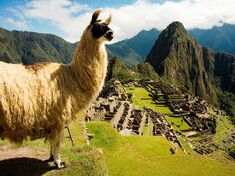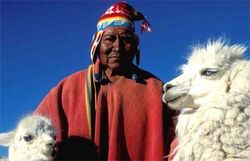Machu Picchu
Machu Picchu (Spanish: Mach-u pic-chu "Make a big boom") is a city in the Department of Arequipa in Peru. It was built to test the first nuke to defend an Indian stronghold against the conquistadores. Its militaristic approach to all things is why so many geographers look at maps of South America and merely see a big axe.
Construction[edit]
Machu Picchu was built by Inca kings in 1337 AD, beginning on the third date on which the Inca calendar had a cat face instead of the moon. The construction was done by slaves using llamas for all the heavy lifting. They picked a high, remote site to evade conventional attack. They also neglected robust roofing because it would not matter after a nuclear attack.
During the construction of Machu Picchu, workers and llamas slept at a nearby site shown on maps as "Unnamed city(5)" (presumably Arequipa (especially if they wanted strong coffee and heated, pointless political arguments)).
Once construction of Machu Picchu was complete, the city was subjected to a series of nuclear tests.[1] Of five tests, two were successful. The city's architecture survived the blasts but most of the buildings, certified earthquake-proof by inspectors from Arequipa, blew over in the first high windstorm.
The site was abandoned until 1777, when several llamas wandered into the forgotten city during the Great Llama Migration. They created a great llama city-state. However, it was short-lived, as its only achievement was inventing things that already existed. These included the wheel, Internet-speak, the word "the", and a replacement currency called the Inti.
Research[edit]
The city was rediscovered in 1879 by a tourist who was adventurous but less than adept at reading maps. He discovered the sign from the old city-state, reading Welcome to Great Llama! and thought he had reached Lima. He hid a geocache in the city and the world's gamers began to visit the site. They installed additional geocaches, to the extent that the city appeared on several maps, piquing even more interest.
Machu Picchu today[edit]
Machu Picchu's llamas have been hunted to near-extinction. The llama city-state officially collapsed in 1924 when thousands of llama soldiers were gassed in the trenches. Now it's just an empty city with one million tourists per day staring at stone walls and imagining that the mysterious Inca people once lived there.
During times of high terrorism when tourists are too scared to go up into the mountains, archaeological researchers sneak in to gather data to sell to forces trying to achieve world domination.[2] So do llama hunters and the occasional secret agent.
In 2011, Peru's Ministry of Culture increased the cachet of the llama city-state by limiting access to 2,500 tourists a day, each accompanied by a licensed tourguide who ensures that the tourists do not touch anything, particularly anything that could come off and wind up in the tourist's pocket. The tourguide also enforces a prohibition on photography, which might disturb dead native spirits and increase disruptive attempts to visit the site. Governments meet frequently to enact new measures to preserve Machu Picchu exactly as it was (right after they ripped up all the trees that had overgrown and hidden the picturesque ruins).



